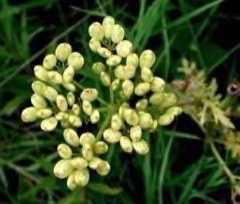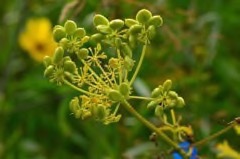 |
|
Dan Busemeyer - www.fs.fed.us |
 |
| Joshua Mayer wikimedia.org |
Translate this page:
Summary
Physical Characteristics

 Polytaenia nuttallii is a PERENNIAL growing to 0.6 m (2ft) by 0.4 m (1ft 4in) at a medium rate.
Polytaenia nuttallii is a PERENNIAL growing to 0.6 m (2ft) by 0.4 m (1ft 4in) at a medium rate.
See above for USDA hardiness. It is hardy to UK zone 5.
It is noted for attracting wildlife.
Suitable for: light (sandy) and medium (loamy) soils and prefers well-drained soil. Suitable pH: mildly acid, neutral and basic (mildly alkaline) soils. It can grow in semi-shade (light woodland) or no shade. It prefers dry or moist soil.
UK Hardiness Map
US Hardiness Map
Synonyms
No synonyms are recorded for this name.
Plant Habitats
Edible Uses
Foragers report seeds are an acceptable substitute for dill in flavor, the leaves can be boiled, and the tap root, supposedly in desperate times, could be boiled or grilled, but has poor favor. Given the similarity in appearance with many other plants, native and non, we would not suggest eating any part of Prairie Parsley [1-5].
References More on Edible Uses
Medicinal Uses
Plants For A Future can not take any responsibility for any adverse effects from the use of plants. Always seek advice from a professional before using a plant medicinally.
None known
References More on Medicinal Uses
The Bookshop: Edible Plant Books
Our Latest books on Perennial Plants For Food Forests and Permaculture Gardens in paperback or digital formats.

Edible Tropical Plants
Food Forest Plants for Hotter Conditions: 250+ Plants For Tropical Food Forests & Permaculture Gardens.
More

Edible Temperate Plants
Plants for Your Food Forest: 500 Plants for Temperate Food Forests & Permaculture Gardens.
More

More Books
PFAF have eight books available in paperback and digital formats. Browse the shop for more information.
Shop Now
Other Uses
Used in habitat restoration projects in prairies and it may be planted as an ornamental. Tiny flowers attract small bees, miscellaneous flies, and occasional wasps. Prairie Parsley is one of the species in the Carrot family that the oligolectic bee, Andrena ziziae, visits for pollen and nectar. The caterpillars of a butterfly, Papilio polyxenes asterius (Black Swallowtail), feed on the foliage of this plant. Cattle and other mammalian herbivores browse readily on the non-toxic foliage [1-6].
Special Uses
References More on Other Uses
Cultivation details
A biennial or short-lived perennial. Easily mistaken for Wild Parsnip, an invasive non-native weed, however, this species has been in decline at least in the periphery of its range due to the destruction of native prairie for agricultural and commercial development. Prairie Parsley leaf looks like flat leaf or Italian parsley and is finely divided while Wild Parsnip leaf is not. Light Requirement: Sun , Part Shade. Soil Moisture: Medium-Wet, Medium, Medium-Dry, Dry. Bloom Color: Yellow. Bloom Time: Jun , Jul. For polyculture design as well as the above-ground architecture (form - tree, shrub etc. and size shown above) information on the habit and root pattern is also useful and given here if available. The plant growth habit is a clumper with limited spread [1-2].
References Carbon Farming Information and Carbon Sequestration Information
Temperature Converter
Type a value in the Celsius field to convert the value to Fahrenheit:
Fahrenheit:
The PFAF Bookshop
Plants For A Future have a number of books available in paperback and digital form. Book titles include Edible Plants, Edible Perennials, Edible Trees,Edible Shrubs, Woodland Gardening, and Temperate Food Forest Plants. Our new book is Food Forest Plants For Hotter Conditions (Tropical and Sub-Tropical).
Shop Now
Plant Propagation
Seed. Cold moist stratification used to simulate the real-world conditions a seed would receive outdoors after the frozen winter gives way to a warm, wet spring. Plant outdoors in the fall [1-5].
Other Names
If available other names are mentioned here
Prairie Parsley, Nuttall's prairie parsley,
Native Plant Search
Search over 900 plants ideal for food forests and permaculture gardens. Filter to search native plants to your area. The plants selected are the plants in our book 'Plants For Your Food Forest: 500 Plants for Temperate Food Forests and Permaculture Gardens, as well as plants chosen for our forthcoming related books for Tropical/Hot Wet Climates and Mediterranean/Hot Dry Climates. Native Plant Search
Found In
Countries where the plant has been found are listed here if the information is available
Weed Potential
Right plant wrong place. We are currently updating this section.
Please note that a plant may be invasive in one area but may not in your area so it’s worth checking.
None Known
Conservation Status
IUCN Red List of Threatened Plants Status : Not Listed.

Growth: S = slow M = medium F = fast. Soil: L = light (sandy) M = medium H = heavy (clay). pH: A = acid N = neutral B = basic (alkaline). Shade: F = full shade S = semi-shade N = no shade. Moisture: D = dry M = Moist We = wet Wa = water.

Expert comment
Author
DC.
Botanical References
Links / References
For a list of references used on this page please go here
Readers comment
| Add a comment |
|
If you have important information about this plant that may help other users please add a comment or link below. Only comments or links that are felt to be directly relevant to a plant will be included. If you think a comment/link or information contained on this page is inaccurate or misleading we would welcome your feedback at [email protected]. If you have questions about a plant please use the Forum on this website as we do not have the resources to answer questions ourselves.
* Please note: the comments by website users are not necessarily those held by PFAF and may give misleading or inaccurate information.
To leave a comment please Register or login here All comments need to be approved so will not appear immediately.
|
Subject : Polytaenia nuttallii
|
|
|
|